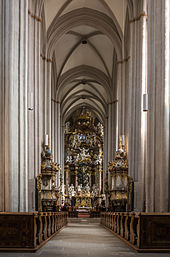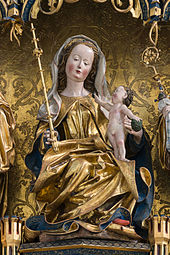Zwettl Abbey
| Zwettl Abbey | |
|---|---|
 Zwettl Collegiate Church |
|
| location |
|
| Lies in the diocese | St. Polten |
| Coordinates: | 48 ° 37 ′ 1 ″ N , 15 ° 12 ′ 0 ″ E |
| Serial number according to Janauschek |
133 |
| founding year | 1138 |
| Mother monastery | Heiligenkreuz Abbey |
| Primary Abbey | Morimond Monastery |
| Congregation | Austrian Cistercian Congregation |
Zwettl (lat. Abbatia BMV de Valle Clara in Austria ) is a Cistercian - Abbey and is located in the Waldviertel in Lower Austria . It has existed without interruption since its foundation in 1138, making it the third oldest Cistercian monastery in the world after Rein Abbey and Heiligenkreuz Abbey. The monastery with the collegiate church is not far from the city of Zwettl of the same name . The monastery building is typical of a cisterce on the valley floor and was built in a bend in the river Kamp .
Historical development
The monastery , founded in 1138 by Hadmar I from Kuenring as the first subsidiary of Heiligenkreuz Abbey , belonged to the filiation of the primary abbey of Morimond Monastery . King Conrad III. confirmed in a document dated October 1139 the manor estate founded by Hadmar and granted the monastery protection and freedom from any bailiwick. The collegiate church was consecrated in 1159. In 1185 part of the South Bohemian Wittingau came to the monastery. This part was sold back to the Landsteiner line of the Witigonen around 1250 . In 1266, with the consent of his wife Gisela von Kuenring , Čeč von Weleschin gave the village of Reinprechts to the Cistercian monastery of Zwettl. Some Kuenringers are buried in the monastery area. The scriptorium of the monastery, which ensured a rapid growth in the book collection, became very important. The Zwettler foundation book, the bear skin from 1311, is one of the most important manuscripts from this period.
The late Romanesque or early Gothic cloister , which encloses the cloister courtyard , is of particular importance in terms of art history . This cloister courtyard symbolizes - like all monastic cloister gardens - paradise . Other gardens are the abbey courtyard , built in the style of Italian palace architecture, and the Prelature Garden , a neo-baroque ornamental garden based on the English model. The early Gothic fountain house and the Romanesque chapter house with its impressive one-column architecture are also significant .
In 1427 the monastery was largely destroyed in the Battle of Zwettl by the Hussites under Andreas Prokop . Little by little, the monastery and the surrounding manor of inherited peasants recovered; the magnificent Gothic collegiate church was completed around 1490. In 1544 Jakob Künigswerth installed the first organ .
In the 18th century, the monastery complex underwent extensive baroque changes ; Among other things, the baroque west tower facade was built by Joseph Munggenast according to plans by Matthias Steinl . With a height of 82 meters, the tower is the second highest tower in Lower Austria. The abbey library , whose colorful ceiling frescoes were designed by the baroque painter Paul Troger , also dates from this period.
organ
Between 1728 and 1731 Johann Ignaz Egedacher from Passau designed the famous organ, which is one of the largest and most expensive organ projects in Vienna and Lower Austria (→ Organs of Zwettl Abbey ).
renovation
From 2007 to 2014 the collegiate church and the other buildings in the complex were renovated at a cost of 13 million euros.
economy
Today, agriculture, forestry, fish farming and wine production in the Schloss Gobelsburg estate are the economic basis for maintaining the monastery. With the establishment of the adjacent military training area after Austria was annexed to the German Reich in 1938, Zwettl Monastery lost over 700 hectares of forest and arable land near the border with Czechoslovakia through forced sales.
Abbots
Abbey parish churches
- Zwettl Collegiate Church
- Parish church Etzen
- 1303/1399 Windigsteig parish church
- 1478 parish church hl. Leonhard in Großschönau , before 1478 parish church hl. Laurentius
- 1765 Parish Church of St. Wolfgang near Weitra
schools
literature
- Karl Kubes, Joachim Rössl, Herbert Fasching: Zwettl Abbey and its art treasures . Verlag Niederösterreichisches Pressehaus, St. Pölten, Vienna 1979, ISBN 3-85326-481-6
- Ursula Pechloff: Zwettl Abbey . Kunstverlag Peda, Passau, 1995, ISBN 3-930102-71-4
- Johann Tomaschek: Cistercian Monastery Zwettl . Brandstätter, Vienna 1989, ISBN 3-85447-323-0
- Evelyn Benesch, Bernd Euler-Rolle , Claudia Haas, Renate Holzschuh-Hofer, Wolfgang Huber, Katharina Packpfeifer, Eva Maria Vancsa-Tironiek, Wolfgang Vogg: Lower Austria north of the Danube (= Dehio-Handbuch . Die Kunstdenkmäler Österreichs ). Anton Schroll & Co, Vienna et al. 1990, ISBN 3-7031-0652-2 , p. 1346-1366 .
- Walter Exner: The Bernhardi Altar in Zwettl Abbey . Siebenberg-Verlag, Bad Wildungen, 1981
- Gerhard Stenzel : From pen to pen in Austria . With aerial photographs by Lothar Beckel. Vienna 1977, ISBN 3-218-00298-2 . P. 54 to 57, Kuenring or Babenberg. Zwettl-Lower Austria, Cistercian Abbey. With an aerial photo of the entire facility. P. 258 f. Pen history. P. 259 Former Collegiate Monastery Zwettl.
Web links
- http://www.stift-zwettl.at/ - Homepage
- Fund: Documents (1055-1742) (Zwettl Abbey) in the European document archive Monasterium.net .
- Photo gallery: Zwettl Abbey
- HDR photos from Zwettl Abbey
Individual evidence
- ↑ Certificate No. 36 in Friedrich Hausmann (Ed.): Diplomata 21: The documents of Konrad III. and his son Heinrich (Conradi III. et filii eius Heinrici Diplomata). Vienna 1969, pp. 58–60 ( Monumenta Germaniae Historica , digitized version )
- ↑ Joachim Bahlcke , Winfried Eberhard, Miloslav Polívka (eds.): Handbook of historical sites . Volume: Bohemia and Moravia (= Kröner's pocket edition . Volume 329). Kröner, Stuttgart 1998, ISBN 3-520-32901-8 , p. 666.
- ↑ Valentin Schmidt and Alois Picha: Document book of the city of Krummau in Bohemia . I. Volume. 1253-1419. Prague, 1908, pp. 2-4.
- ↑ Report in the morning news of Radio Niederösterreich on ORF on May 1, 2014








